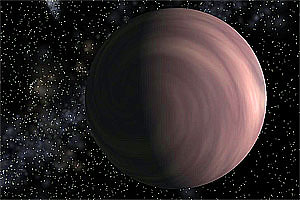 Artistic rendition of exoplanet Gilese 436 b, created in Celestia
Artistic rendition of exoplanet Gilese 436 b, created in Celestia
In the past fifteen years, the search for other Earths-- and possibly life-- outside our own solar system has taken off. As of May 2008, 293 extrasolar planets have been confirmed. Most of these planets are big, gas giants like our own Jupiter but new technology is helping astronomers get closer to finding earth sized planets. To find an extrasolar planet scientists first identify a star and then, using different methods, look to see if there is a planet, or planets, orbiting the star. It’s estimated that at least 10% of sun-like stars have planets.
Once astronomers have found an extrasolar planet, also called an exoplanet, they look to see if it is in the Goldilocks zone. This is an area of space in which a planet is just the right distance from its' parent star so that the surface is neither too hot nor too cold. A habitable temperature means that the planet could possibly host liquid water, an ingredient for life.
A number of exoplanet findings have come from astronomy teams in Switzerland and near San Jose at Lick Observatory. Astronomers at Lick made news in the fall of 2007 when they discovered 55 Cancri. The discovery of the five-planet system came after nearly 20 years of observations. Also in 2007, astronomers with the Geneva Extrasolar Planet Search Program discovered the most earth-like planet ever found. Gilese 581 c lies in the Goldilocks Zone, it's surface temperature ranges from an estimated 32 degrees Fahrenheit to 102 degrees Fahrenheit. The research team that discovered the new planet believes it may have a developed atmosphere and be covered with oceans.
Curious to see how astronomers hunt for extrasolar planets, I took the trip up the long, windy road to the top of Mt. Hamilton. It is a beautiful drive up to the observatory and it's wise to take your time so that you can enjoy the ideal California landscape of rolling hills dotted with oak trees and wildflowers. The 365 sharp curves along the 19 mile road will also slow you down.
At the top of Mt. Hamilton are several white domes dotting the 4,200-foot crestline. From Lick Observatory you can see forever-- not just across the vast northern California landscape but out into our own galaxy and beyond. By coincidence, the night I was there astronomer Debra Fischer confirmed five new planets outside our solar system. The discovery was the culmination of five years of watching these specific planets from Lick's 3-meter Shane Telescope. Fischer and her colleague Geoff Marcy will publish their findings soon. These two astronomers are obsessed with looking for exoplanets, they just returned from the Andes mountains in Chile, where they spent day and night for several weeks hunting for planets. But Fischer and Marcy are not the only ones who have caught the exoplanet bug.
